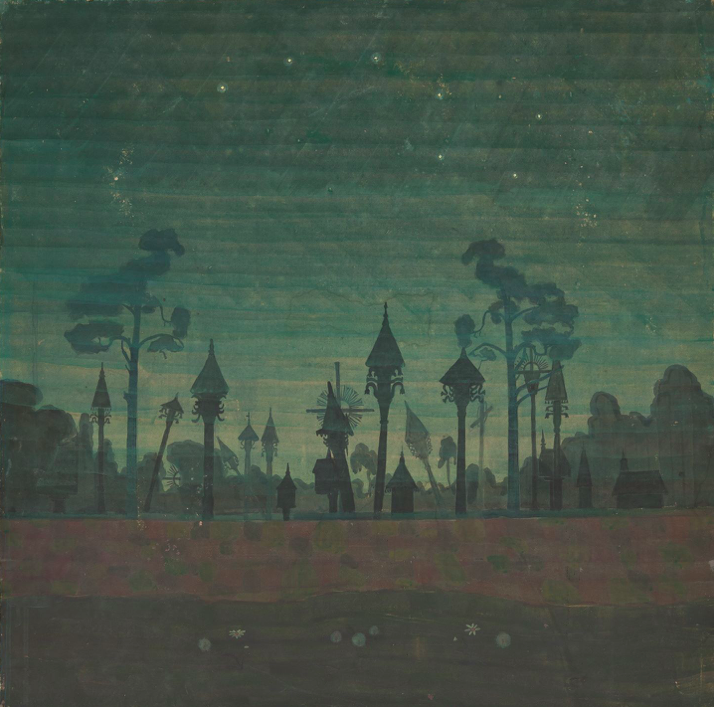A Fire in His Soul: How Paris Changed Vincent van Gogh
In his new book A Fire in His Soul, Miles J. Unger gives us Vincent van Gogh as we’ve never seen him before—abrasive, intransigent, egotistical,...
Ledys Chemin 21 February 2025
22 September 2023 min Read
The stars, the moon, the sun – all celestial bodies have inspired art for centuries. However, as we look at Mikalojus Konstantinas Čiurlionis’ space paintings, we can see that the creative mind of an artist can sometimes foresee what science discovers decades later. His paintings created at the beginning of the 20th century seem to resemble what we know from modern space research programs – in Hubble and Webb’s images.

Mikalojus Konstantinas Čiurlionis, Lithuanian Graveyard with the visible Big Dipper, 1909, M. K. Čiurlionis National Art Museum, Kaunas, Lithuania.
The Lithuanian Symbolist painter M. K. Čiurlionis was interested in everything he could get his hands on, so space and concepts on planet formation were no exceptions. It is known that he was enthralled by French astronomer‘s Camille Flammarion (1842-1925) writings and ideas regarding topics such as life and vegetation on Mars, and the possibility of life to transcend universes (layering of the cosmos). While Flammarion’s research was not so concrete and more on the spiritual side, we can look at now proven theories formed by Pierre-Simon Laplace (1749-1827) and Immanuel Kant (1724-1804). These two scientists and philosophers offered their views concerning the formation and evolution of the solar system: the nebular hypothesis.
In his 13-painting cycle Creation of the World (1905/1906), Čiurlionis explores the idea of the formation of the world. One of the paintings in the cycle shows the hand of God and the words “Aris”. In the series, we also see a possible God with a billowing pipe of gas which it strangely reminiscent of Hubble’s photo of colliding gases in the Running Man nebula.
Of course, it is far-fetched, but Hubble’s image sure looks like a bowed head with a crown (even if it is just various gases clumped together) and resembles the painting created 100 years before. Here people who are not so versed in astronomy might ask: Why are we placing so much importance on gas in space?
If we follow the nebular hypothesis (which was suggested by Pierre-Simon Laplace and whom M. K. Čiurlionis read), the universe was formed from gas and dust. (This might be the reason why Čiurlionis created a painting with God and his pipe with billowing smoke.) As the gases clump together, we see a new planet forming (which is depicted in the second painting of the series). Even though Čiurlionis painted this before modern telescopes and the possibility to accurately capture any forming stars, if we look at Hubble’s photos, we are shocked to discover the uncanny similarities, especially regarding the blue hues.
Another resemblance to Hubble’s photos sneaks up on us in a music-space cycle Sonata I – Sonata of the Sun (1907). In this sonata, Čiurlionis paints a cycle of the sun – from small stars (suns) to its death (which is symbolized by a still bell). Of course, the second image – Andante attracts us with the grandiosity of the sun and its flares. Look at the similarity between Čiurlionis’ space painting and NASA’s photo from 2000. Even the storm swirls in similar patterns!
In the Finale, we see not only an image that was captured later but also the idea of the cosmic web or galaxy filaments (as they are called now). This is something which was not known at beginning of the 20th century. Čiurlionis, while probably trying to show the stillness of the bell, unintentionally depicted the cosmic structure that was discovered in the late 1980s.
Now let’s get back to Hubble’s photos: Have you heard of Pillars of Creation?
If you look at Čiurlionis’ painting Finale, we see kings sleeping on pillar thrones. In his work, kings (especially kings in space) represented the Rulers or Creators of the world. Now, 100 years later, we see a similar structure in the image of the Pillars of Creation.
It is no question that at the time M. K. Čiurlionis was creating, space and galaxy studies were attractive to everyone and it’s no wonder to see him inspired by it as well. Nevertheless, it is stunning to see that the ideas and motifs he created are not so far off from reality. As Hubble and other telescopes continue photographing the depths of the universe, we are left to wonder: What else will they capture that might be similar?
Guest Author’s bio:
Greta Katkeviciene is an employee of M. K. Čiurlionis National Museum of Arts, with a goal to introduce the undiscovered genius that was M. K. Čiurlionis to the world.
DailyArt Magazine needs your support. Every contribution, however big or small, is very valuable for our future. Thanks to it, we will be able to sustain and grow the Magazine. Thank you for your help!